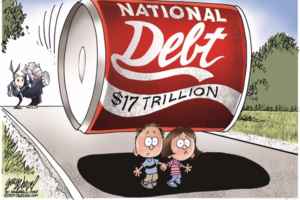The U.S. Treasury recently announced the federal budget deficit is on track to surpass $1 trillion in fiscal 2020 – the country has not experienced such an eye popping number since 2012.
The deficit was abnormally high during Obama’s presidency as the administration fought to recover after the “Great Recession” delivered a death blow to the economy. In 2015 – the federal deficit was at a low of $442 million.
The federal deficit has risen every year since 2016 and it’s causing Treasury officials to scramble as they issue more debt to cover the ever deepening gap.
Republican budget hawks during Obama’s tenure were highly vocal and routinely challenged the president by imposing spending caps and frequently showed a willingness to shut down the government when those constraints were breached. However the same politicians have been missing in action – they raised spending caps and even funded Trump’s tax cuts virtually through additional debt issuance.
We often heard Republicans screaming for entitlement reform to pull down government borrowing – but those screams are now barely a whisper. GOP leaders in Washington no longer see the need to restructure Social Security and Medicare; both account for an outsize portion of the federal budget and are the fastest growing expenditures.
Democratic presidential candidates don’t even mention the crippling federal deficit or national debt at all – in fact they are proposing new spending in the form of student loan forgiveness and Medicare for all.
Treasury Secretary Steve Mnuchin has floated the idea of utilizing a new 20-year note to ease funding pressure. Interest rates on the federal debt have remained low despite the expanding debt issuance and that has given cover to politicians who would normally be a lot more expressive about the situation. If the market drove rates up, then borrowing costs would become more expensive and people would quickly take notice.
For now, the global market seems to be comfortable with lending to the U.S. Treasury, despite low interest rates and large appetite for government debt. The U.S. dollar is the world’s reserve currency and that also places the U.S. in a better position than other countries.
Not to mention historic low unemployment is helping to mask the ballooning deficit. Unemployment is the lowest it’s been in 50 years, which means the labor market is tight and tax receipts are high, and that provides further leverage for the Treasury to keep borrowing.
Undoubtedly rising budget deficits have contributed to the U.S. government’s national debt surpassing $23 trillion for the first time in history. Just under $17 trillion is public debt and the other $6 trillion is inter-government borrowing.
Since Trump taking office, the national debt has grown 16%; it stood at $19.9 trillion at the time of his inauguration. If voters give Trump another term in office, then he plans to add $9.1 trillion for both terms. Obama added $8.6 trillion over his combined years in office – a 74% increase from $11.7 trillion that he inherited from Bush.
Large federal budget deficits and expanding national debt harms the economy in ways that are often unnoticeable. For example, government borrowing diverts private savings away from private investment, making it more challenging for start-ups and existing corporations to attract capital for entrepreneurial activity.
It’s also worth noting as the national debt continues to grow it crowds out other important areas of the federal budget – healthcare, defense, education, and infrastructure spending – making it much harder for elected officials to find resources for these critical investments. For instance, the government spent $376 billion to pay interest on the federal debt in 2019 fiscal year, which equates to nearly half the entire defense budget and more than what was allocated to education, agriculture, transportation, and housing combined.
This is a very important election year and voters must challenge lawmakers to provide much needed insight on how they plan to address out of control spending in Washington. We need a fiscal austerity program that drastically reduces annual deficits, while continuing to focus on private sector growth to generate revenue to bring down the overall national debt.




